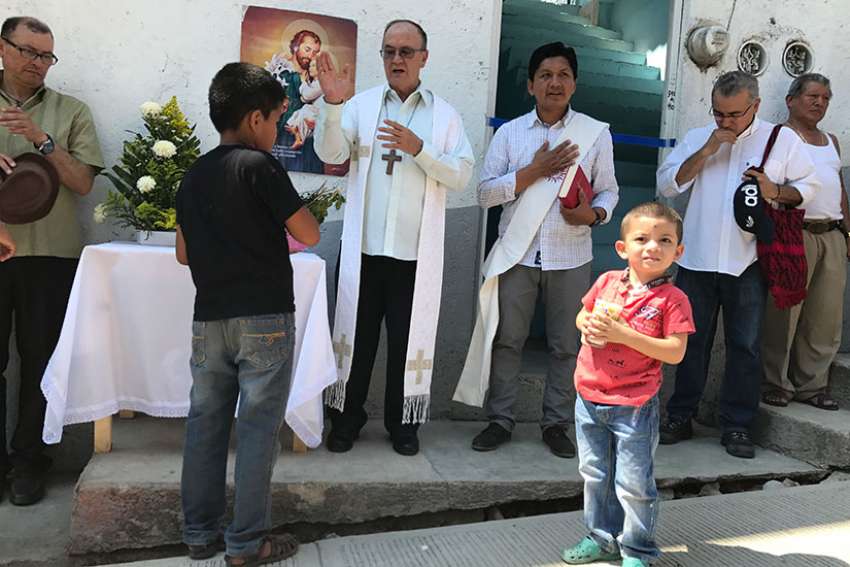"The parish has always been a welcoming place for migrants," said Sister Maria del Carmen Diaz, a nun working in the parish. "People here don't have much money. But they offer what they can and, what little they have, they share. There's a sense of solidarity."
The parish opened the St. Raphael shelter for migrants in 2011, but it went unused as Central Americans, fresh from crossing the border, tended to move on quickly and head north toward the U.S. border. But the shelter was recently expanded – in cooperation with the Jesuit Migration Service and with financial support from the U.N. High Commissioner for Refugees – and inaugurated as a longer-stay shelter for those seeking asylum in Mexico.
The renovations and change of mission reflect the new reality of Central Americans arriving in Mexico in search of shelter and a safe place. They're increasingly staying put and seeking asylum status in Mexico instead of risking trips to the United States.
"The grand illusion of the American Dream is still there, but it's diminished somewhat," said Jesuit Father Conrado Zepeda.
Father Zepeda cited several reasons for the diminished interest, including difficulties in transiting the country: Kidnapping, extortion and crimes committed against migrants are common. Mexico has detained and deported more than 300,000 Central Americans since 2014 as part of the Southern Border Plan, which the government unveiled to make migration safer and to stop migrants from riding atop freight trains. Critics contend the increased enforcement has prompted migrants to take even riskier and less-plied paths through Mexico and has led to abuses against them by criminals and crooked authorities.
The thinking now among migrants, said Father Zepeda, is: "If I cannot make it to the United States, then I'll stay in Mexico. It's a little safer than my country and salaries are better."
The expanded shelter provides more space for families, rather than just single men spending a night or two. Most refugees require a stay of several months and some sort of legal assistance in order to process their asylum claims, Father Zepeda said.
Manuel, 23, is among those seeking refugee status in Mexico. He worked as a security guard and did not think about migrating, but ended up fleeing violence in his native El Salvador, saying members of the MS-13 street gang accused him of robbing a house.
"They threatened me with a knife to my throat," said Manuel, who did not give his surname for security reasons. "Thankfully, they didn't kill me."
Manuel arrived in Mexico, but was robbed and detained some 150 miles from the border. He suffered a broken arm while in detention and was subsequently allowed to stay in the country. Manuel has since applied for asylum in Mexico, saying it would be impossible to return to El Salvador.
He is among the thousands of Central Americans fleeing some of the most violent countries in the world: Guatemala, El Salvador and Honduras – with the murder rate topping 80 per 100,000 in the latter two nations.
Mexican government figures show an increase in asylum claims of 156.4 percent in 2016, when compared with the previous years, while the acceptance rate has increased and fewer claims are being abandoned.
It's not the first time Mexico has experienced an influx of asylum seekers. Starting in 1982 an estimated 80,000 refugees – many of them indigenous Maya – arrived from Guatemala after being driven from their lands. Bishop Samuel Ruiz Garcia, then leader of the San Cristobal de Las Casas Diocese, organized parish teams to receive and pastorally tend to the refugees, while ordinary citizens opened their homes.
The tradition of serving migrants continues in the diocese and in parishes like Santo Nino de Atocha, where a migrant ministry of more than 20 lay members helps those arriving.
"Migration has structural issues, which we here cannot resolve, but we can do our part in the diocese," said Coadjutor Bishop Enrique Diaz of San Cristobal de Las Casas. "Almost all of the parishes have a group attending to it, but undoubtedly, Comalapa is the parish that has committed the most."
The solidarity shown with refugees in towns like Frontera Comalapa, where small-scale agriculture underpins the economy and poverty is pervasive, serves as an example for others turning toward isolation and prioritizing parochial matters, says one Jesuit leader.
"In the beginning it was poor indigenous and campesino families that offered hospitality to refugee families," said Jesuit Father Jose Luis Gonzalez, southern coordinator for Jesuit Migration Service in Mexico. "We're showing today, in the times of Donald Trump, that it's the poor who are the first ones to show hospitality."


